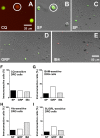Roles for substance P and gastrin-releasing peptide as neurotransmitters released by primary afferent pruriceptors
- PMID: 23155177
- PMCID: PMC3567390
- DOI: 10.1152/jn.00539.2012
Roles for substance P and gastrin-releasing peptide as neurotransmitters released by primary afferent pruriceptors
Abstract
Recent studies support roles for neurokinin-1 (NK-1) and gastrin-releasing peptide (GRP) receptor-expressing spinal neurons in itch. We presently investigated expression of substance P (SP) and GRP in pruritogen-responsive primary sensory neurons and roles for these neuropeptides in itch signaling. Responses of dorsal root ganglion (DRG) cells to various pruritogens were observed by calcium imaging. DRG cells were then processed for SP, GRP, and isolectin B-4 (IB4; a marker for nonpeptidergic neurons) immunofluorescence. Of pruritogen-responsive DRG cells, 11.8-26.8%, 21.8-40.0%, and 21.4-26.8% were immunopositive for SP, GRP, and IB4, respectively. In behavioral studies, both systemic and intrathecal administration of a NK-1 receptor antagonist significantly attenuated scratching evoked by chloroquine and a protease-activated receptor 2 agonist, SLIGRL, but not histamine, bovine adrenal medulla peptide 8-22 (BAM8-22), or serotonin. Systemic or intrathecal administration of a GRP receptor antagonist attenuated scratching evoked by chloroquine and SLIGRL but not BAM8-22 or histamine. The GRP receptor antagonist enhanced scratching evoked by serotonin. These results indicate that SP and GRP expressed in primary sensory neurons are partially involved as neurotransmitters in histamine-independent itch signaling from the skin to the spinal cord.
Figures




References
-
- Andoh T, Kuwazono T, Lee JB, Kuraishi Y. Gastrin-releasing peptide induces itch-related responses through mast cell degranulation in mice. Peptides 32: 2098–2103, 2011 - PubMed
Publication types
MeSH terms
Substances
Grants and funding
LinkOut - more resources
Full Text Sources
Other Literature Sources
Medical
Molecular Biology Databases
Research Materials

